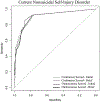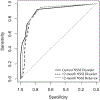The Screen for Nonsuicidal Self-Injury: Development and initial validation among veterans with psychiatric disorders
- PMID: 35257418
- PMCID: PMC9378472
- DOI: 10.1111/sltb.12847
The Screen for Nonsuicidal Self-Injury: Development and initial validation among veterans with psychiatric disorders
Abstract
Introduction: Nonsuicidal self-injury (NSSI) is associated with significant impairment and is a robust predictor of suicidal ideation, attempts, and death by suicide; however, the present lack of a brief screening instrument for NSSI coupled with consistent underidentification of NSSI in male adults has led to concerning rates of missed identification of NSSI.
Methods: The Screen for Nonsuicidal Self-Injury (SNSI) is a brief, 10-item screen designed to identify individuals currently engaging in NSSI with an emphasis on behaviors more frequently endorsed by male adults. The present study examined the development and validation of the SNSI.
Results: In a sample of veterans (N = 124) with complex psychiatric presentations, SNSI scores demonstrated good internal consistency and strong construct validity with area under the curve (AUC) estimates of 0.85-0.93 for the identification of NSSI disorder. SNSI scores also demonstrated good convergent (rs 0.59-0.90) and external validity (rs = 0.25-0.42), and excellent predictive validity identifying future NSSI Suicide and Life-Threatening Behavior disorder (AUC = 0.88) and NSSI behaviors (AUC = 0.90). Importantly, SNSI performance was not affected by participants' race, sex assigned at birth, or age.
Conclusion: The SNSI is an efficient screen to identify patients engaging in NSSI who are likely to benefit from more comprehensive assessment and treatment programs.
Keywords: nonsuicidal self-injury; nonsuicidal self-injury disorder; self-harm; veterans.
© 2022 The American Association of Suicidology.
Conflict of interest statement
Figures



References
-
- American Psychiatric Association. (2013). Diagnostic and statistical manual of mental disorders (5th ed.). https://doi.org/10/1176/appi/books.9780890425596
-
- Bliese PD, Wright KM, Adler AB, Cabrera O, Castro CA, & Hoge CW (2008). Validating the Primary Care Posttraumatic Stress Disorder Screen and the Posttraumatic Stress Disorder Checklist with soldiers returning from combat. Journal of Consulting and Clinical Psychology, 76, 272–281. 10.1037/0022-006X.76.2.272 - DOI - PubMed
Publication types
MeSH terms
Grants and funding
LinkOut - more resources
Full Text Sources
Medical

